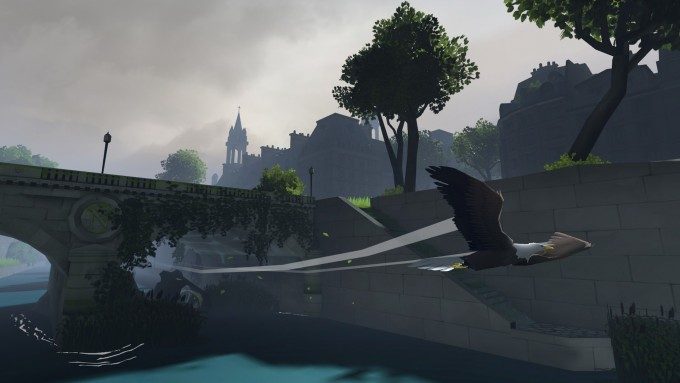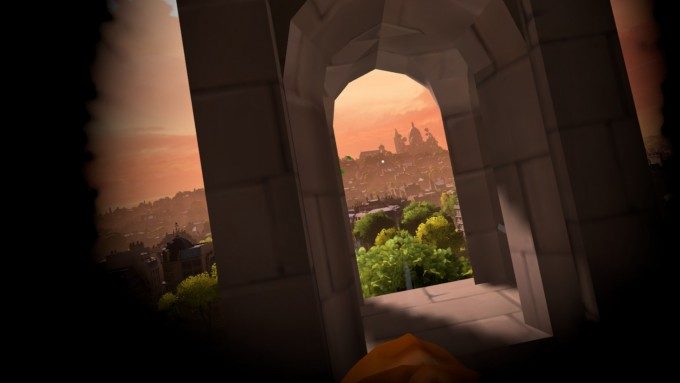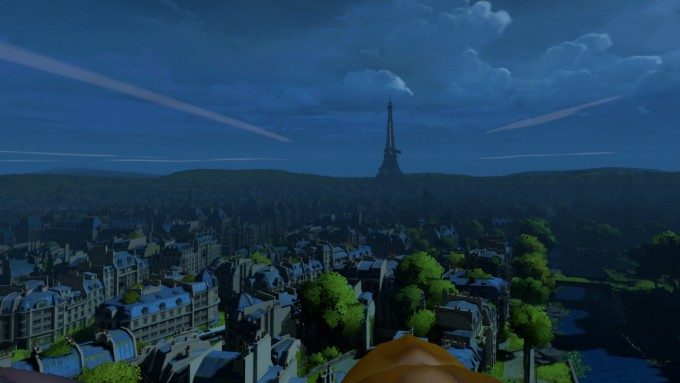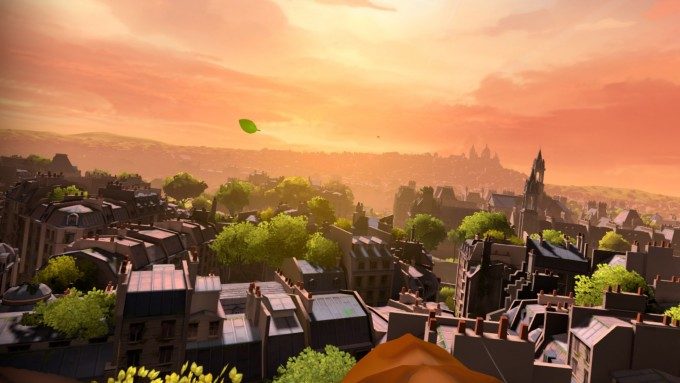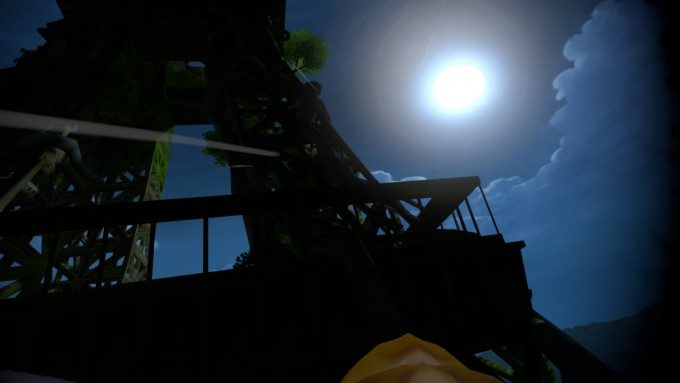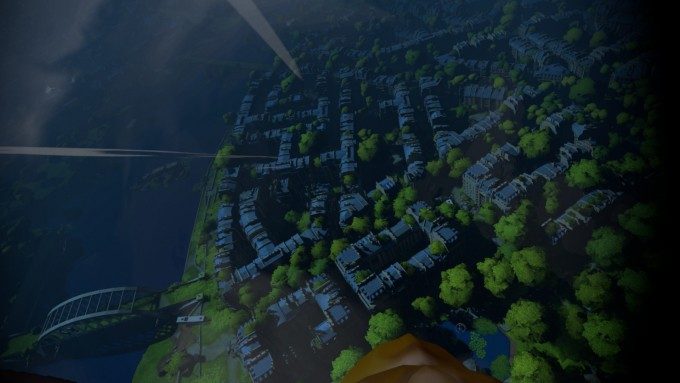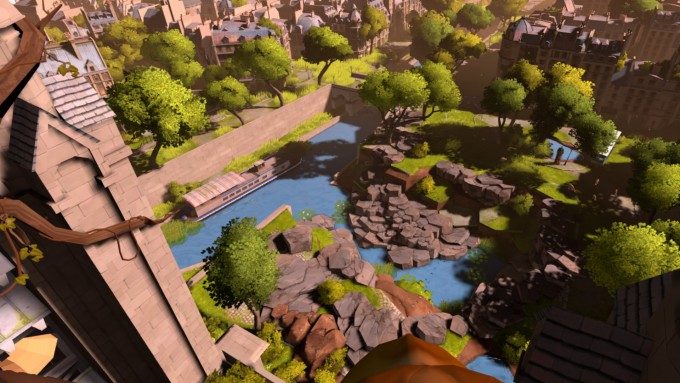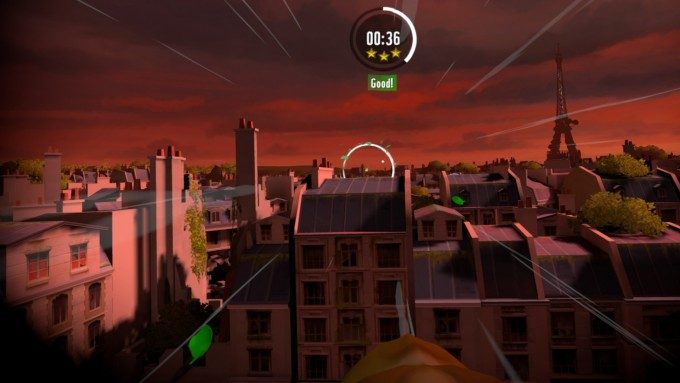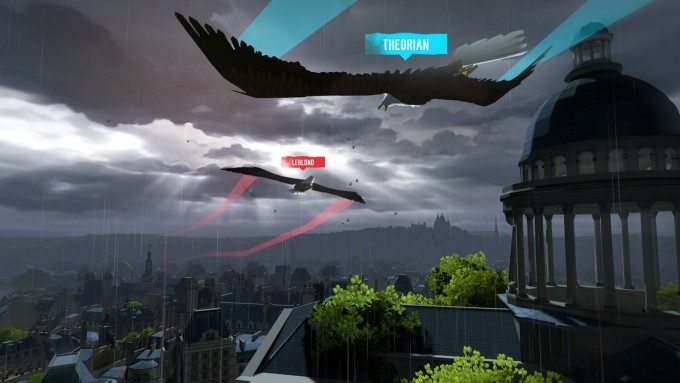After years of previews and teasers, Ubisoft make their long anticipated VR debut on Oculus Rift and PlayStation VR. Eagle Flight has all the hallmarks of being a toe in the water for Ubisoft, but the VR world may feel the ripples for some time to come.
Eagle Flight Details
Official Site
Developer: Ubisoft
Publisher: Ubisoft
Available On: Oculus Rift, PlayStation VR and HTC Vive (Dec 20th)
Reviewed On: Oculus Rift
Release Date: October 18th, 2016
Gameplay
Eagle Flight. As a title for a game, it is wonderfully unambiguous. Eagles fly and eagles hunt. Simple. This isn’t a bombastic experience casting you as the hero of the brave eagle rebellion, fighting against tyranny across a war-torn Paris as Drill Sergeant Tweet O’Sparrow bellows missions at you. There aren’t deep ties to the Assassin’s Creed franchise, from which much of the city layout was apparently cribbed before being heavily customised. Eagles fly and eagles hunt – and that’s pretty much all you will do across a memorable Paris cityscape, devoid of people, that has been reclaimed by nature and escaped zoo animals. Simple, right?
What that title doesn’t convey is all of the influences you can feel layered throughout the experience. There’s a dash of Pilot Wings when diving through rings on courses that trace astonishing routes through the city. There’s a hint of Ace Combat around the aerial encounters with other predators, with the B-52-like wingspan and laboured turning of Vultures mixed with Crows, Bats and (F-16) Falcons that are all assuming archetypal air combat roles. The twitch reactions of Wipeout can be sensed as you thread your way through an underground catacomb race, expertly dodging obstacles on a course you’ve already attempted a dozen times in an effort to shave valuable seconds off your time. There’s even a dash of the free running from Mirror’s Edge, whose gameplay beats can be felt here as you mutter to yourself “…under bridge, into sewer, through spinning fan, out of tunnel, hard right, steep climb, avoid branches, through building…” Moves that you’ve committed to memory in an effort to secure the full complement of three stars from one of 17 Expert Challenges and 23 Story Missions. There’s also a multiplayer mode supporting up to 3 vs. 3 gameplay to satisfy any competitive needs.
I completed the story in around six hours, but at that point had only collected 60 out of a possible 129 stars. I have since logged at least the same number of hours again while exploring the world and attempting to better my performances. I fully intend to dive further into the multiplayer once the player base expands, at which time I’m predicting that people on my friends list will be destroying the times I’ve posted in the races – a situation I will need to remedy with extreme prejudice. With the Expert Challenges locked out until you achieve a set number of stars there’s ample reason to go back and three-star the earlier missions. Given the fun I’ve had, the fun I still intend to have, and the amount of content on offer, the $40 (£30, €40) asking price for the PSVR version seems fair, with Oculus Store prices in the same ballpark. We are leaving the time when the VR release schedule is mainly populated by tech demos and shorter experiences. While this isn’t quite the AAA experience we might have hoped for, it’s in a different league to many of this year’s other releases.
But that is only to speak of the practical: the game modes and the content It misses the emotive side of the game. There are times when you will gracefully bank around wide boulevards before darting through a collapsed wall into a building, threading your way through layers of detritus before bursting through a smashed window on the far side. Peeling upwards, narrowly missing a chimney stack atop a Parisian terrace, with the streets falling away beneath you suddenly you see it reaching high into the sky: the Eiffel Tower, resplendent, with the sun low on the horizon and wrapping the city in an amber haze. This is nothing less than intoxicating, and moments just like it keep happening again and again as you play with a very pleasant musical score enhancing the mood.
It’s hard to be cynical about Eagle Flight when it takes you back so perfectly to childhood dreams of flight. But not the mechanical facsimiles of flight other games deliver: the joy of real flight, with no barrier between your instinct and your reaction. Where you look is where you fly, and a tilt of the head puts you into a turn the severity of which is determined by how far you tilt. It takes a little while to learn and settle into its rhythms, to avoid the temptation to turn your whole body and get entangled in the headset cables, but once you find your groove it is this direct connection between you as the player and you as the eagle that makes this game sing. There is no joystick, there is no delay, there is only instinct and instant reaction. Left and right triggers slow or boost your flight, abilities that come into their own in some of the catacomb challenges where the speeds are extreme – think Wipeout fast – and the twists and turns, dips and rises, demand every ounce of concentration you can muster. To beat the target time you will want to avoid hitting the brakes, as it were, at all costs. This ends up with you almost daring yourself to hold steady, to risk everything to go just a little faster for just a little longer before losing your nerve.
To slow is to falter, to stop is defeat: run into a wall, or even just clip the scenery, and it’s back to the beginning. The underground time trials feature multiple paths, with the best routes often quite hard to ferret out, and always featuring boost zones, narrower tunnels and more violent changes in direction. Some of the layouts are infuriatingly complex, but always thrilling. As most trials are finished in under two minutes – which admittedly can feel like an eternity when you’re so completely focussed – there’s always that tug to have just one more go, to see if you can shave off another second and get that elusive third star. It’s the only time in the single player game where you really feel a palpable fear of failure, as you speed through narrow tunnels making turns that would cause The Flash to think twice, with your potential demise apparent in every curving wall and piece of jutting debris. When you do finally piece together that perfect run, the resulting endorphin rush is intense.
Over the course of the 23 story missions, the game takes you on a sightseeing tour of the city and gradually expands your repertoire of skills as each of the five main areas unlock. Each area is centred on a well known landmark, such as Notre-Dame or the Louvre, making it easy to orient yourself. Early missions introduce you to basic flying and collecting, and when you have your wings (pun intended) combat is introduced. These aerial battles expand in scope as the game progresses, with offensive and defensive abilities triggered by the face buttons on the controller. The combat usually boils down to chasing your targets and trying to lead your fire just enough that your projectile screech attack will catch them. In later missions you come under considerable fire yourself. Even if it sometimes feels a little arbitrary, with the game not making it easy to sense where attacks are coming from, it is nonetheless a great deal of fun. Time trials, escort missions and challenges likewise ramp up in scale, scope and difficulty as the game proceeds. All of this is enjoyable enough, but is also neatly priming you for the multiplayer mode you will eventually gravitate to.
Supporting a maximum of six players from 1 vs. 1 to 3 vs. 3 teams, the multiplayer sees each team attempting to capture the prey and return it to their nest. The highest score when the timer expires wins. It’s a simple premise, but one that ties in neatly to everything that’s great about Eagle Flight. I’ve only had an opportunity to try 1 vs. 1 combat, but I can confirm that this mode adds the sense of danger that is sorely lacking from the single player modes. As you collect the prey and start flying toward your nest, you can sense the opposition player homing in. You dive, in a panic, trying to find safety among the ruined streets below. Closer and closer comes the predator that is now stalking you from above. Screech attacks whizz past, you change direction desperately, now disoriented as well as under attack. You are as much at risk from crashing into the landscape as you are from the enemy. When the tables are turned there is a vicious thrill in being the hunter. Reeling in your target from afar, watching their trajectory and unleashing an attack at just the right moment. Adding more players into the mix would only make this more frenetic.
There is of course the elephant in the room when it comes to VR multiplayer. A smaller install base of hardware than traditional PC or console games enjoy means a naturally smaller player base. It’s not unfair to imagine that it will be tough to even get a game in a few weeks, much less a balanced one. It’s not much fun to be outmatched, and I can imagine that a well organised team could run rampant over weaker opposition which would kill the fun somewhat. So the multiplayer, while good, probably shouldn’t be the major purchasing decision even if it feels like there are a good many hours of potential fun in there. I hope to be proven wrong, and fully intend to be glued to my Rift over the coming weeks to play this.
Returning to the single player portions of the game, the open world has two types of collectibles that have a distinctive sound effect you can hear when you get close. Waterways in each area contain fish that leap into the air as you approach, and you will need to be carrying enough speed to snatch them before they hit the water and disappear again. You will often spy the telltale ripples in the water from a distance, throw yourself into a steep dive, and pull up just in time to snatch the fish from the air. There are also collectible feathers, but thankfully what was a chore in the Assassin’s Creed series is more enjoyable here – though still frustrating when you simply can’t locate the feather that you can hear is nearby. Locating both fish and feather is a tempting diversion when flying between the locations that trigger missions and challenges. You start at altitude, picking off the obvious feathers that are highly visible on rooftops and bell towers, then you swoop lower and start scouring the streets, rivers and forests for likely nooks and crannies. As your confidence in flying increases, and your ability to navigate ever more cramped areas develops, it feels like peeling away layers of the city. You find yourself taking more risks through congested streets where twisted tree trunks snake around buildings – routes that would have felt impassable when you first started playing – and the time you spend scouring the streets is all honing your skills and abilities for the time trials.
The unsung hero that enables all of this ducking and diving through the game at high speed is the world design. While rendered in a very simplistic style, with low polygon counts and limited texturing and lighting, the landscape is eminently readable. The designers have done a good job of engendering trust. When you dart into a building, you are trusting that there is an escape on the other side. When you fly off the beaten track, you trust that your escapade down twisting streets won’t end in a cul-de-sac, and if it does you know you can always just look up and soar to the safety of the open sky. It is only in the rare moments when the level design does let you down, with a piece of unfair collision detection or a blind turn into a massive wall, when you realise how much you’ve taken the excellent design for granted elsewhere.
On the subject of the visuals there is no escaping the fact that we are looking at a game targeting the lowest common denominator which in this case is the PS4 and 970 series GPUs. Add in the choice of Unity as the engine, with its infamously bad multithreading support, and it’s easy to see why the team at Ubisoft have erred on the side of caution, putting performance above all else. As impressive as it is to be able to climb to altitude and take in the whole city from horizon to horizon at a rock-solid frame rate, there is no avoiding the disappointingly primitive hills that ring the play area, the lack of variation in many of the buildings, the poor combat effects and the overly simplistic grass effects and tree foliage. It’s Assassin’s Creed by way of Wind Waker – looking its best from a distance – and as a result I have to admit that much of my time with the game at first was spent lamenting the fact that it wasn’t pushing my GPU to its limit; in fact there are absolutely no settings for graphical configuration in the game. It is what it is, and you can’t nudge any settings higher on more capable GPUs.
Based on how crisp it looks on the Rift I suspect that there is some automatically applied supersampling – with the internal resolution selected based on the capability of the GPU that the game detects – but this is only an assumption, and it could just as easily be the artistic choices that make the game look as sharp as it does. However if my suspicions are correct, and further assuming that lower level GPUs and the PS4 might lack this feature, the eminently readable world design should ensure that the experience was not unduly compromised by a drop in resolution. It may be worth waiting for early user impressions to confirm this. As much as it’s tempting to stop and over-analyse the simplistic visuals, this is a game about flying. When you’re screaming through the world at high speed, you don’t stop to count polygons or contemplate janky animations. As the game cycles between day and night, between sun, rain, fog and clear conditions, and as you fly between a herd of Zebra running over a bridge you start to appreciate the atmosphere it generates. It is a world to experience in perpetual motion. Slow too long, look too hard, and the illusion is broken.
Where the game really suffers is in your lack of influence over the world. There is no hunting of food for survival, there is no fear of being hunted yourself, there is just you, the city, and the missions. If you dwell on it too long it can make the game feel sterile, the lack of any meaningful reaction to your presence an immersion killer, and it’s hard to escape the notion that there was far more potential here in the world and the gameplay than the team have delivered. Instead they fell back on the usual tropes, and if we’re being reductive the game boils down to a chain of missions that are loosely disguised time trials, areas that are artificially locked, a bunch of collectibles and the obligatory multiplayer mode bolted on. What I wouldn’t give to sit in on a design meeting for any sequel!
But being reductive misses the point, and just a few hours in I realised that this had become one of my favourite VR experiences. Eagle Flight reaffirms that there is ample mileage in seated VR experiences – without room scale, and without tracked controllers – to go along with games and experiences that embrace those technologies. I’m extremely envious that for a lot of PlayStation VR gamers, and for people coming later to the Rift party, this could be their first experience of VR. It’s not perfect, it’s not as imaginative as it could have been, but it sidesteps some of VR’s hardest problems and delivers a memorable, exciting, and challenging experience. Eagles fly. Eagles hunt. Join them.
Immersion
The exceptional feeling of immersion in Eagle Flight comes from the control scheme. You are in control of everything – not just where you go, but how you get there. You can climb to altitude and take a direct route. You can get down to the level of the forest canopy and weave between trees. You can get right down to the street level and weave around, through, and under buildings as you like. Skim above the river and you raise plumes of water with your wingtips. No other game lets you indulge your whims in quite this way. When you eventually trigger a time trial, you trade freedom for focus and attempt to apply your skills to the challenge at hand. It’s a great blend of gameplay, and it kept me hooked on the game for long stretches.
Some games fare better than others from being viewed through VR goggles. Eagle Flight has chosen its animal well because staring through the lenses of the Rift, with the Eagle’s beak – my beak – intruding slightly where my nose should be, and feathers intruding slightly from the sides, feels just right. This is all you will ever see of yourself in the game but it’s just enough to remind you what you are, what you’re doing, and to help you forget that there’s a big lump of plastic wedged on your head. At one point I spent a continuous five hours playing the game without leaving VR. The time, if you’ll excuse yet another terrible pun, simply flew by.
While much of the game takes place in the open world, where you can move fairly seamlessly from free roaming to missions, there are some missions and challenges that take place underground and necessitate loading in additional level data. In an apparent effort to hide this data loading, 3D video footage of the upcoming area is used to bookend the event. On PC at least, this is significantly lower fidelity than the realtime rendering and the difference is jarring. Aside from looking bad: one moment you have supreme comfort, and the next any shifting in your seat induces that disconnect common to all 3D video that can be nauseous. It’s the lack of warning as you move between the two modes of rendering that jars the most. Frankly I’d rather have a blank screen, or a static image of the event projected into space in front of me.
There are other times when it’s actually the gaminess of Eagle Flight that intrudes. Playing the story mode, certain areas of the city are out of bounds because they are controlled by the Falcons. Rather than have Falcons hunt you down for trespass, a giant message appears on the screen: “This area is controlled by the Falcons, turn back now!” And then a timer counts down from five, after which you are respawned back in your own territory. A similar message and countdown appears if you attempt to fly out of the city. It’s not subtle, and completely kills the immersion. Likewise the nagging that tilting your head is better than turning it. I KNOW! I KNOW! I’VE BEEN PLAYING FOR FIFTEEN HOURS! I KNOW! Sitting, as I have been, in a swivel chair it’s sometimes hard in all the excitement not to get a little turned around. Having a massive icon and text appear right in the middle of the screen, right in the middle of a time trial or some aerial combat, is ridiculous. It cost me success in more than one challenge, and I resented it every time. Yes it’s my fault that I’m no longer facing forward, but surely there has to be a better solution than this messaging!
Speaking of aerial combat, the screech attack that you perform isn’t the most visually appealing effect – a spherical transparent ball that you project into the world. The combat is basically a game of projectiles, and with every other element of the experience conveying the nature of Eagle life so seamlessly this was always going to be a tough element to graft on. Similarly when you knock a bird out of the sky they seem to just pop out of existence to be replaced by a few feathers rather than plummet to the ground. At these times the game underneath intrudes too far and the immersion suffers.
One element I wasn’t expecting to break immersion was the music – and in the main it’s wonderful – but there are one or two pieces that crop up that use painfully synthetic sounding string ensembles rather than a live orchestra, and it is somewhat distracting after the polish evident in most of the other tracks you will hear that nicely sit in the background, enhancing the atmosphere.
Comfort
By this point, eagle-eyed readers will be wondering why there has been no mention of nausea and simulator sickness. There’s a simple answer for that: there isn’t any to speak of. It is only in extreme, sustained, turns and dives that the telltale lurch in the stomach intrudes, and even in those cases the effect is short lived. I am susceptible to simulator sickness, but in more than 15 hours with the game – including one five hour long continuous stretch – over the last few days I have felt extremely comfortable. You have absolute control over the camera, with your head, and therefore absolute control over how intense you want your journey to be on a moment to moment basis.
The work the team at Ubisoft have done to explore, understand, and eradicate simulator sickness will be the lasting legacy of the game. It may not apply to many other experiences – after all, it is unlikely that this will spawn a new genre of bird simulators – but it does show that a motivated team with enough time to test, learn and iterate can find solutions to these sorts of problems. The vignetting that kicks in as you turn and as you pass too close to objects in the world, whilst being moderately distracting at first, is very effective at managing nausea and even becomes part of how you sense your place in the world. Other techniques such as spawning leaf particles in the sky ahead of you, speed lines, and of course the Eagle’s beak always make sure there’s something closer in to focus on to help you sense motion and your place in the world.
So confident was I in Ubisoft’s achievement that I conducted a human experiment on a VR virgin. While the telltale lurch in the stomach was there during dives and turns, the effect was as short lived for them as it had been for me. I observed my friend all evening, and there wasn’t even a slight hint of motion sickness.
When you crash in the game, and you will crash, the display abruptly fades to black and leaves you with a simple “you died!” message. This isn’t especially comfortable, but is an unavoidable side-effect of the game’s covenant to only ever fly where you’re looking. Were the game to bounce you off things, or otherwise take control of the camera, this would be lost and nausea would kick in. It took a few hours before I made my peace with this screen, which you will be seeing a lot in quick succession when trying to three-star the expert level time trials, and in truth I doubt going from blistering speed to a black screen is ever going to be entirely comfortable.
There is a function that unlocks at the end of the story mode: free look. You can hold down A on the controller to look around without changing heading. This of course opens you up to a small potential for nausea depending on the angles you find yourself flying at, and the fact that you’re no longer looking in the direction of motion. When you release the A button the direction of travel snaps to where you’re now looking. Like the death screen, this is largely unavoidable, but is uncomfortable nonetheless. When hunting down those last few collectibles, or trying to spot an enemy eagle in the multiplayer, I’d happily trade a little comfort for the ability to scan my environment more accurately from on high. It was wise to leave this ability until the player has spent many hours getting used to how the game operates.
As mentioned above, any time when 3D video replaces the real time renderer the game suffers from all the known side effects of consuming VR content that way. The final aspect of the game that impacts player comfort is actually comfort of the physical variety. You will be moving your head around almost constantly, and tilting a lot. In an effort to avoid obstacles that suddenly appear in front of you, you may find yourself instinctively snapping your head up, down or to the side as a last ditch effort to avoid crashing. While I never caused myself injury, I have to admit that I do feel like I’ve done a mild neck and shoulder workout these last few days.
Summary
Eagle Flight brings the unbridled joy of flying to VR. With its sense of speed, stern challenge, and unparalleled levels of control and comfort it’s only the fact that it plays so safely within its own sandbox that stops it getting a perfect score.


